
Apple’s iPad Pro M4 is an exceptional tablet, but unless you can change up your work style, it’s not quite a MacBook Pro replacement quite yet for most people.
| Pros | Cons |
|---|---|
| M4 is stupidly powerful | One USB port is seriously limiting |
| Display screen is truly lovely | Needs pricey accessories to make the most of it |
| Good battery life | Can’t get the best processor without getting the highest storage tiers |
Score: 3.5/5
 |
Buy The iPad Pro M4! | Buy On Amazon |
In this review
iPad Pro M4 Specifications
iPad Pro M4 Design
iPad Pro M4 Performance
iPad Pro M4 Battery
iPad Pro M4 Conclusion
Design

Thin is in.
Apple has long been working on slimming down its iPad lines, and for the 7th Generation iPad Pro line – which I’m going to mostly call the iPad Pro M4 from now on, because I feel like that’s clearer – it’s made the interesting shift to a truly thin design that means that the iPad Pro line – and especially the larger iPad Pro M4 13 inch – is actually thinner than the iPad Air M2 released at the same time.
It’s the iPad-Thinner-Than-Air, in essence, with Apple arguing that its 5.1mm thickness (5.3mm on the 11 inch model tested here, and no, I don’t know why that is either) adds a degree of portability to the design.

The iPad Pro M4 is, indeed, thin.
It’s undeniably an impressive bit of engineering, but I honestly do feel that some of the hype is very much overblown in this case, because the thinness of the iPad Pro M4 – even the “chunkier” 11 inch model – is only really impressive on first glance and first usage, and largely because Apple’s made so much noise (and one slightly misfired ad) around it. The drop in weight here is perhaps more impressive, with the 13 inch model weighing in at 582g compared to 685g for its 12.9 inch predecessor, though the drop for the 11 inch model is less marked at 446g compared to 466g for its 11 inch predecessor.
There are some small design changes in the iPad Pro M4 that make a big difference, like the shifting of the primary front-facing camera from the top of the portrait side to the top of the landscape side, which is a lot more friendly for video conferencing meetings – or even if you just have to hold the iPad Pro M4 for any length of time in a Facetime call – though it’s disappointing for its “Pro” tablet that we’re still stuck with just one primary USB-C/Thunderbolt port. More on that later.
The big change for the iPad Pro M4 is the way that Apple’s now building the screen, whether you get the big 13 inch or 11 inch models. Resolution at 2420x1668 (11 inch) or 2752x2064 (13 inch) is pin sharp, but it’s the use of stacked OLED panels that gives the iPad Pro M4 really superb presentation.
OLED is often held as the best-in-class technology for TV panels thanks to the fact that it can present absolutely perfect blacks, and here it presents wonderfully, with support for dynamic refresh rates from 10Hz up to 120Hz – “ProMotion” in AppleSpeak – and it really is a very nice panel that suits its Pro moniker well, because it’d work exceptionally for matters like photo or video editing on the go without having to particularly stress shifting to a larger reference monitor.
Apple also offers a variant of the iPad Pro with Nano Texture glass finishing, meant to reduce even more glare. I can't speak to how effective that might be -- Apple only sent me the standard glass model to test out -- but if you're keen because you work outdoors, there's a limiting factor here, because it's only available as an extra cost option on the 1TB or 2TB iPad Pro models. Why does better glass need more storage on board, Apple?
What you don’t get with Apple’s Pro line of iPads is a whole host of colour choices. The iPad Pro M4 sells in Silver or Space Black finishes, and that’s it. Compared to the four colour choices that the iPad Air M2 gets, it feels kind of limiting.
Performance
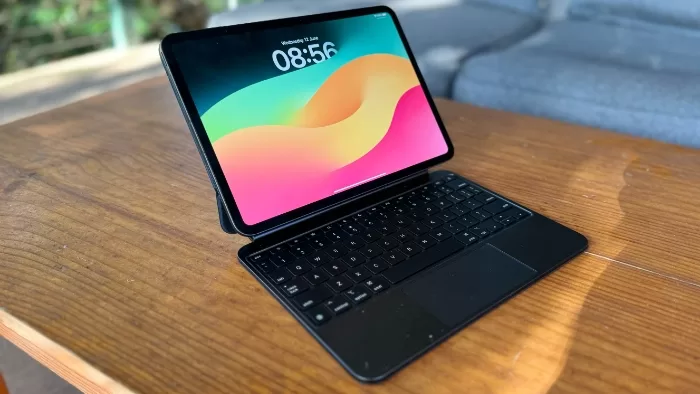
Apple positions the iPad Pro as its professional-grade tool — if you just want a tablet for surfing the web or playing games, that’s what the iPad 10th Gen and to a certain extent the iPad Air M2 is for — and that puts it in direct competition with the MacBook Pro line.
Or in this case, ahead of it. Apple’s decision to debut the M4 line of processors in the iPad Pro M4 is a rather direct statement about where the future of Apple’s computing lines are likely to head. Probably not this year — for reasons that I’ll get into — but definitely on an ongoing basis if the most powerful hardware it’s got is going into Pro level tablets first.
Make no mistake, the M4 is a powerful little beast of a processor too, though it’s worth noting that not all M4s are created equal. If you opt for an iPad Pro without 1TB of storage, then you get an M4 system with a 9-core CPU and 10-core GPU, plus 8GB of onboard RAM, while those with 1TB get a 10-core CPU, 10-Core GPU and 16GB of RAM.
Where regular consumers might not be quite so fussed about technical details, I do feel as though the pro market Apple’s chasing with the iPad Pro M4 will care, and this isn’t terribly evident at the point of sale.
The model that Apple’s loaned me was a 1TB model, so that’s got the full-fat M4 and full quantity of RAM as well, albeit at a cost of $2749, or $2929 if you wanted the Nano texture glass variant. So how does it compare to older iPad Pro models or MacBook Pros?
Very well indeed. Here’s how it compared in a straight line Geekbench 6 CPU shootout:
There is admittedly a pretty hefty price gap between the M3 MacBook Pro there and the M4 iPad Pro, though it does punch above it in single core operations, and leaves open the possibility of M4 Max MacBook Pros in the future – though only Tim Cook knows for sure on that score.
Also Read:
Having a lot of power is one matter, but having something to do with it is another, and in years past I’ve commented that the iPad Pro always felt like this massive engine revving but with nowhere to go. Apple has done some commendable work bringing a wide variety of applications to iPadOS with a focus on mostly professional applications, as well as a few select AAA game titles that do come up well on the iPad Pro M4.
There’s little doubt that you can do some very solid creative work on these platforms in an illustration, document markup, video editing or music creation sense, and that for some this might just be the ideal tool thanks to the inclusion of touch controls and light carrying weight.
However, to make the most of the iPad Pro M4, you’re probably going to have to spend even more money to get it up to creative speed. If you want a keyboard for the iPad Pro M4, you will have to spend extra ($499 11 inch/$579 13 inch) for the new Apple Magic Keyboard for iPad Pro.
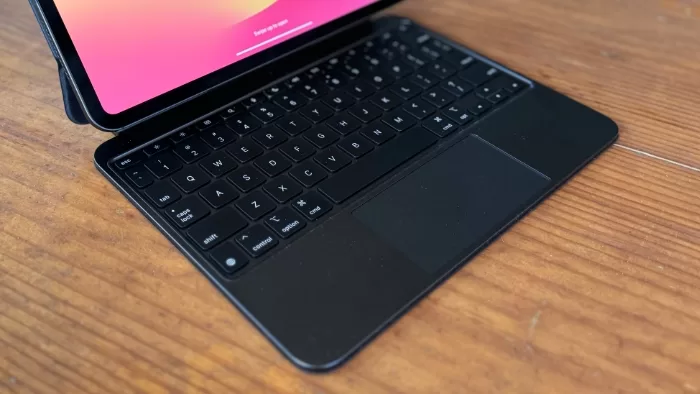
The Magic Keyboard is a beautifully made tablet keyboard... but like the iPad Pro, it's not cheap.
If you’re an older iPad Pro owner with an existing Magic Keyboard who figured you could re-use it… you can’t. Given the high price that Apple charges for their Magic Keyboards, that’s a somewhat bitter pill to swallow, even though it is undeniably a nice bit of kit that does come a lot closer to making the iPad Pro M4 more of a viable MacBook Pro competitor.
The other challenge there is that it adds a fair degree of thickness and weight to the iPad Pro M4. It’s unavoidable of course, but we’re no longer in the “Thinpossible” (Apple’s term, not mine) realm here. You can somewhat sidestep that with just a standard case rather than the Magic Keyboard, and I'll always advocate for cases, but again you're on the hook for yet more money when you do so.
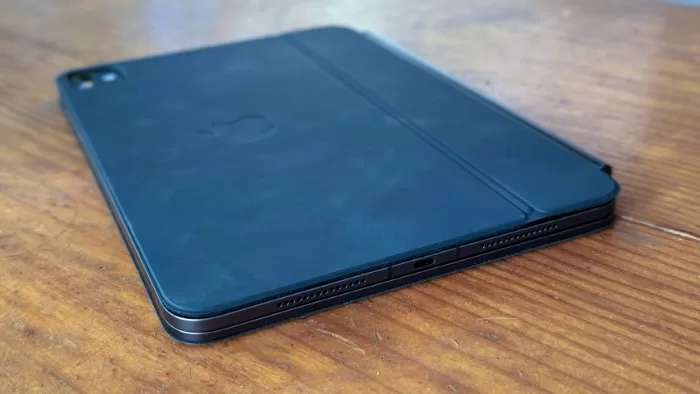
We have officially left "Thinpossible" territory, folks.
If you’re more of a stylus user – I’ll be honest, that’s not me really – then the new Apple Pencil Pro offers a nice array of new creative tools too.
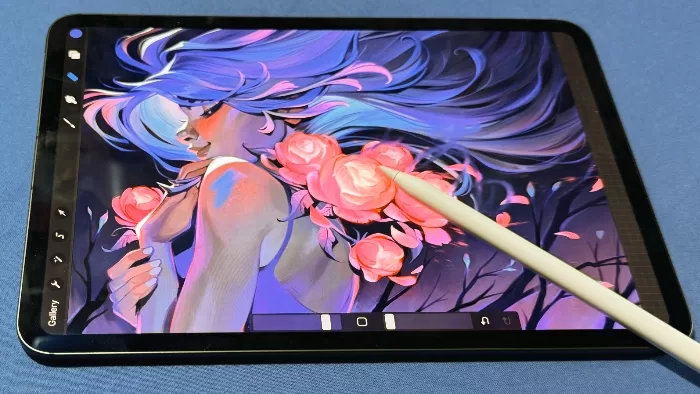
Would you believe I drew this? No? You're very wise (it's a default Procreate image)

This is more my skill level.
I’m still a lousy artist, so it’s a bit beyond my capabilities if I’m honest – but if you want that, it’s another $219 on top. For years now I’ve complained in my reviews of Microsoft’s Surface Pro lines that the stylus and keyboard are pricey extras, so it’s only fair that the same standard applies to the iPad Pro.
Even then, there are limitations in hardware and software to bear in mind, depending on your workflow. Apple’s only ever sold the iPad Pro with a single port, and while it’s Thunderbolt/USB 4 compatible for maximum speed… there’s still just only one of them.
That’s going to mean either buying a USB-C hub (and hoping it works, because Apple never publishes guidelines on compatibility) or doing a lot of device swapping. There’s no headphone/microphone 3.5mm jack, and while that’s not new to this model, it may limit audio creatives wanting to use the iPad Pro as their main machine too.
iPadOS is nicely fluid, and you absolutely can feel the power of the platform in play when jumping between applications or as part of a wider Mac ecosystem if that’s your play, but there’s still some solid barriers in play between sharing files out cleanly and neatly that no amount of AirDrop (if it’s not being temperamental) can solve.
You can multitask on an iPad, and have been able to do so for some time, but it’s an inconsistent beast at best, with some workflows just plain falling over and limits on the number of windows that just aren't the case on a (technically weaker) MacBook. Try playing audio in one app and then starting it in another, and you only get the one stream, where on a Mac you’d get that mixed.
Again, that’s a workflow story, and I can accept that there are ways to work around them… but I’m not sure it’s the best play to have to do that. I can totally see why Apple pushes that, because the more controlled space of iPadOS allows it to collect all those tasty app store fees and shift specific creative apps to subscription models while it’s at it. That’s not a reason why you should buy one, just a reason why they’re pushing them so heavily that way.
The iPad Pro M4 comes in either a direct Wi-Fi configuration with support for Wi-Fi 6E (802.11ax), or in a Wi-Fi+Cellular variant, costing a little extra. It’s 5G-capable – sub-6GHz only in Australia, grr – but the big change here is that there’s no SIM card tray at all.
Apple’s gone pure eSIM for all iPad Pro models, arguing that the convenience of setup trumps all. I’m not really in the workspace where the presence or absence of a SIM card in an iPad’s made a big difference to me – my OG iPad was a SIM-enabled model and I think I used it once before working out hotspot mode was honestly easier and cheaper – but if your work situation relies on physical SIM cards for some reason, this could be an issue.
Battery
The M4 chip is powerful, but what does leveraging that power look like in day to day use? As always, it’s dependent on what you’re doing with the iPad Pro M4.
On days where I’ve used it as a research/reading/writing device, it’s come fairly close to Apple’s claimed 10 hours of usage, but if I’m pushing it harder, it’ll drop down more into around a six hour range.
While iPhones dropped in-box chargers some years back, you’ll still find one in the iPad Pro M4’s box; specifically a 20W USB-C adaptor that will take some time to fully recharge a depleted iPad Pro M4.
Apple iPad Pro M4: Alex’s Verdict
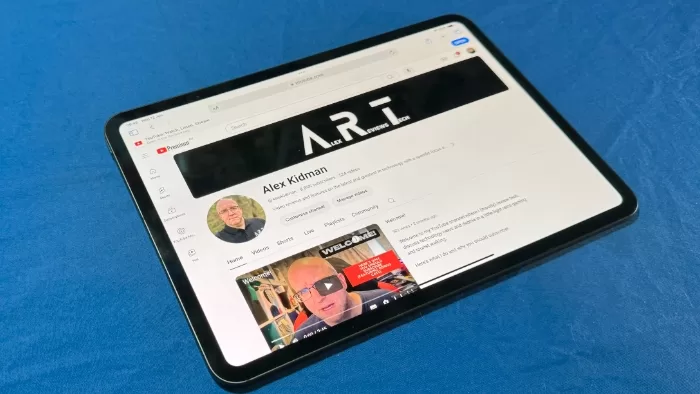
Is the Apple iPad Pro M4 the best tablet that Apple’s made to date?
Without a shadow of a doubt.
It’s insanely powerful, the screen is lovely and tweaks like shifting the camera to the landscape side make it a far more useful machine. Match it up with a Magic Keyboard and/or Apple Pencil Pro, and you’ve got a truly powerful tablet system on your hands.
You’re also going to have to spend a lot more for it, however, and this is where I have pause for thought. For some specific workflows, especially if the Apple Pencil Pro is part of that workflow, I can totally see it making all the sense in the world for very mobile users who won’t get on with the touch-free environment that is macOS today.
However, iPadOS retains Apple’s essentially locked-down system design, and that does limit some of the ways you can work with its systems that aren’t present on a competing MacBook Pro (or, if you prefer, a decently powerful Windows 11 machine). The lack of expansion ports, the slightly clunky way you have to work with external files, the way that the sound system works across multiple applications, somewhat inconsistent multi-tasking… there are real issues here for professional users that shouldn’t be glossed over just because it’s sexy and thin now.
It is also galling that Apple doesn’t make all glass options or CPU/GPU options available at all storage tiers either – and I hate that, there’s never a specified reason why Apple does this beyond that it can – and that prior accessories mostly don’t talk to the new iPad Pro models at all, so if you’ve invested already and were looking to upgrade, you’re on the hook for new and pricey accessories as well.
Then there’s the pricing. It starts at $1,699, but that’s for an 11 inch model with 256GB of storage and Wi-Fi only. The model as tested (1TB, Wi-Fi+Cellular, Standard Glass) would run $3,099, or $3279 if you wanted the nano texture glass option.
Adding on the Magic Keyboard and Apple Pencil Pro punches that up to $3,997. If you wanted an iPad Pro M4 13 inch with all the trimmings, you’re looking at depleting your wallet to the tune of $4,698.
For sure, in some working environments that’s a price that might be entirely affordable because of the amount of extra work you might be able to do that only really works within a tablet ecosystem, but that is still just a niche of the wider working space.
It’s pretty clear that Apple really is positioning itself for a shift towards the iPad Pro given it’s been gifted the M4 processor first – but that doesn’t make it the right choice for everyone, or at least not yet.
Apple iPad Pro M4: Pricing and availability
The Apple iPad Pro retails in Australia with pricing starting at $1699.
 |
Buy The iPad Pro M4! | Buy On Amazon |
Was this review useful to you? Support independent media by dropping a dollar or two in the tip jar below!









